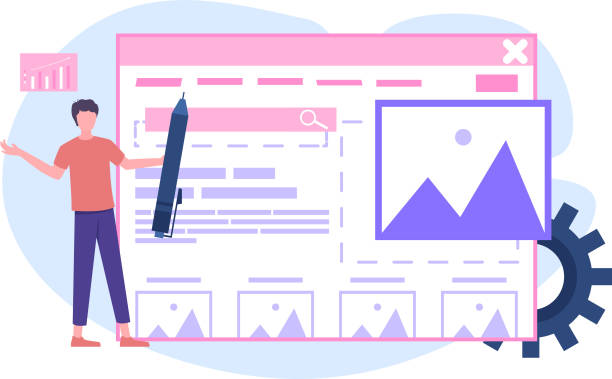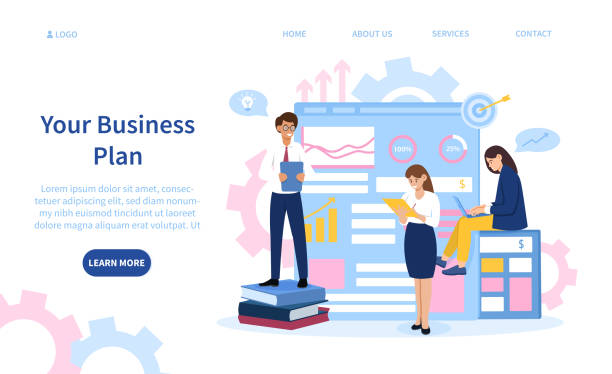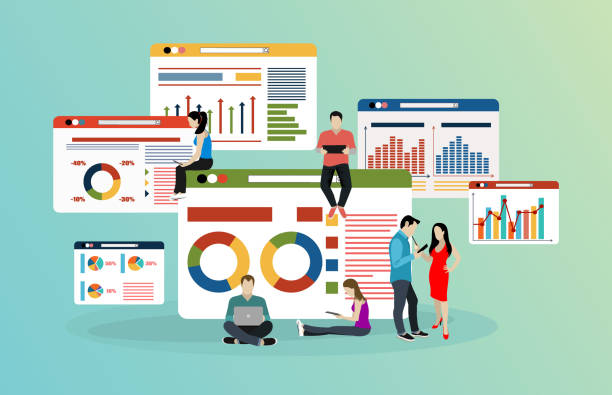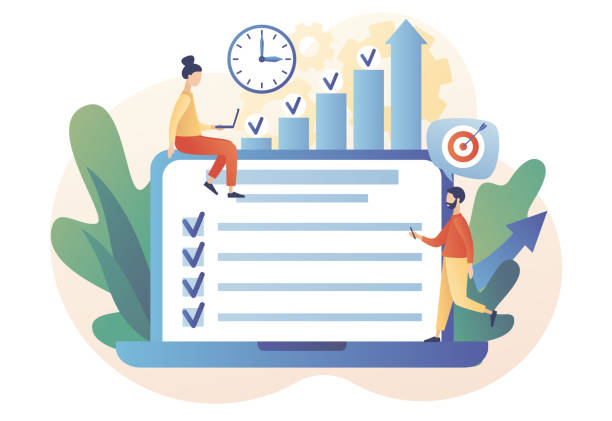The Unparalleled Importance of Multilingual Website Design in Today’s World

In the era of #globalization and #cross-border_communications, an online presence is an undeniable necessity for every business.
But is this presence limited solely to your customers’ native language? The emphatic answer is no.
Today, multilingual website design is not just a competitive advantage, but a vital imperative for reaching global markets and attracting a wider audience.
This approach is, in fact, a bridge for crossing geographical and cultural boundaries, enabling effective communication with customers from all over the world.
By providing content in users’ native languages, you not only gain their trust but also create a deeper and more personalized user experience for them, which in turn leads to increased conversion rates and customer loyalty.
This is a #specialized and #strategic step for expanding the reach of any brand’s activities.
Globalization of businesses means accessing new markets and attracting international customers, and a multilingual website is the gateway to this arena.
A website offered in multiple languages not only helps meet users’ linguistic needs but also demonstrates respect for the cultures and linguistic differences of the audience.
This point is particularly important in today’s competitive markets, where every detail can help differentiate a brand.
As an #educational guide, it can be said that the first step in this path is understanding the importance of language and culture in the user experience.
Many businesses lose significant opportunities in international markets due to a lack of attention to this issue.
A multilingual website allows you to convey your message in a way that is not only understood but also aligns with the audience’s culture and traditions.
This approach is not limited to mere word translation but includes localizing content, images, currencies, and even date and time formats.
Investing in multilingual website design means investing in sustainable growth and access to the endless potential of global markets.
This action not only helps increase sales but also strengthens your credibility and branding internationally.
Finally, it should be noted that the existence of a communication platform with multi-language support is a way to achieve greater diversity in the customer base and create more meaningful and long-term relationships with them.
Research shows that 80% of customers trust companies with a professional website more. Does your current website inspire this trust?
With Rasaweb’s corporate website design services, solve the problem of customer distrust and a weak online image forever!
✅ Create a professional image and increase customer trust
✅ Attract more sales leads and grow your business
⚡ Get free consultation
Key Considerations Before Starting a Multilingual Website Design Project

Before embarking on the execution process of #multilingual_website_design, it is essential to consider a precise set of #initial_considerations and #strategic_planning.
This phase is of paramount importance, as the decisions made here form the foundation of your project’s success.
The first step is to determine the languages in which you intend to offer your website.
This choice should be based on market research, target audience analysis, and consideration of commercial potentials in different regions.
Are your audiences in Europe or Asia? What are the dominant languages in these regions? This is an important #analytical question that must be answered carefully.
After identifying the languages, you should consider the type of content that needs translation.
Should all website pages be translated, or only the main sections? Should your #news and #blog content also be multilingual? These decisions directly impact the project’s budget and timeline.
Choosing the right platform is also a critical factor.
Are you using a Content Management System (CMS) like WordPress with multilingual plugins, or are you looking for dedicated and customized solutions? Each platform has its own advantages and disadvantages, and its selection should be based on your technical and budgetary needs.
Next, you should consider the SEO strategy for each language.
Keywords may differ in various languages and require separate research.
Localization is not just translation; it involves adapting content to the culture, values, and even humor of a specific region.
This aspect of the work is a #specialized and #guiding part that requires the expertise of localization translators.
Ignoring these points can lead to misunderstandings and even unintentional offenses, resulting in customer loss.
Finally, you should think about the content update process.
How do you publish new content simultaneously in all languages? Will you use a Translation Management System (TMS)? These questions require precise and long-term planning to ensure your multilingual website remains always up-to-date and efficient, providing the best experience for global users.
Technical and SEO Aspects of Multilingual Website Design

When it comes to #multilingual_website_design, #technical and #SEO (Search Engine Optimization) aspects play a vital role, and if not managed correctly, they can render all your efforts fruitless.
One of the most important concepts in this regard is the correct use of the `hreflang` tag.
This tag informs search engines like Google that similar pages with identical or similar content exist, but for different languages or geographical regions.
Incorrect use of `hreflang` can lead to duplicate content issues and a decrease in search ranking.
This part of the work is highly #specialized and #educational, requiring deep knowledge in international SEO.
The URL structure is also of great importance.
You can use subdomains (e.g., `es.example.com` for Spanish), subdirectories (e.g., `example.com/es/`), or country code top-level domains (ccTLD) like `example.es`.
Each method has its advantages and disadvantages.
For example, ccTLDs generally offer the best local SEO performance, but their management can be more expensive and complex.
Subdirectories are the most common and manageable option, while subdomains require more technical configuration.
Choosing the correct URL structure based on your goals plays a key role in the successful implementation of a multilingual website.
Duplicate content between different language versions of a website is a major SEO concern.
Using `hreflang` along with `canonical tags` helps search engines identify the correct language versions of each page and prevents penalties due to duplicate content.
This is an #analytical aspect that requires precision and high technical knowledge.
Furthermore, website loading speed for each language version and in every geographical region is crucial.
Using Content Delivery Networks (CDN) can help improve speed for users worldwide.
Finally, you should consider optimizing images and videos for each language and region.
This includes translating Alt Text and image descriptions so that search engines can correctly index your visual content as well.
The table below compares different URL structure methods for multilingual websites:
| URL Structure Method | Example | Advantages | Disadvantages |
|---|---|---|---|
| Country Code Top-Level Domains (ccTLD) | example.es |
Strong local SEO, clear geographical separation | More expensive, requires separate hosting, management complexity |
| Subdirectories | example.com/es/ |
Easy for SEO management, cost-effective, common | May not be as strong as ccTLD for local SEO |
| Subdomains | es.example.com |
Flexibility in hosting and management | Search engines may view them as separate sites |
Content Localization and Translation Strategies in Multilingual Website Design

Mere word translation is only a small part of the #localization process in #multilingual_website_design.
For your website to truly connect with local audiences, you need a more comprehensive approach that involves adapting content to the cultural, social, and even political nuances of each region.
This work goes beyond machine translation and requires the expertise of localization translators who are not only fluent in the target language but also thoroughly familiar with the culture, local idioms, and user expectations of that region.
This approach is a vital #guidance for ensuring the accuracy and relevance of content.
Using professional and native translators helps you prevent cultural or linguistic errors that could harm your brand.
For example, a joke or an image that is perfectly acceptable in one culture might be considered offensive in another.
Therefore, the selection of appropriate content, images, symbols, and even colors must be done with great care and research.
This process is a #specialized part of localization that is often overlooked.
Furthermore, attention must be paid to date and time formats, currency units, measurement systems (e.g., metric or imperial), and even names and phone numbers to ensure the user experience feels completely native and natural.
Another important aspect is the translation and localization of keywords for SEO.
Keywords that generate high traffic for you in one language might have a different meaning in another language or might not be searched by users at all.
Therefore, keyword research for each language should be conducted separately and by native specialists.
This deep #analysis prevents the wastage of SEO budget.
#Questionable content can be challenged in this section; is your content flexible enough to be localized without losing its core message?
Additionally, you should consider a Translation Management System (TMS).
These systems can simplify and streamline the translation process, especially if your content volume is large and you require frequent updates.
TMSs facilitate collaboration between translators, editors, and project managers, helping maintain the consistency and quality of translations across all languages.
Investing in efficient translation management for a multilingual website means ensuring quality and speed in content publishing on a global scale.
Are you worried that your company’s old website will drive away new customers? Rasaweb solves this problem with modern and efficient corporate website design.
✅ Increases your brand credibility.
✅ Helps attract targeted customers.
⚡ Contact Rasaweb for a free consultation!
The Importance of User Experience (UX) in Multilingual Website Design

User Experience (UX) plays a pivotal role in the success of any website, and this importance is amplified when it comes to #multilingual_website_design.
A successful multilingual website, beyond mere content translation, must provide a flawless and intuitive experience for users from different cultures and languages.
This means paying close attention to details that might be overlooked in a single-language website.
The first and most important aspect is an #easy_and_accessible_language_switcher.
Users should be able to easily and without confusion select their desired language.
Typically, a dropdown menu in the website’s header or footer, or flag icons, are popular options.
This is an important visual #guidance.
Furthermore, the design must be flexible to accommodate different text lengths in various languages.
Some languages, like German or Finnish, may have much longer words than English, which can affect the website’s layout.
Therefore, responsive design and sufficient space for text expansion are essential.
Text direction (such as right-to-left for Persian or Arabic, and left-to-right for most languages) must also be correctly implemented to ensure content #readability.
This is a #specialized aspect of design that requires technical skills.
Visual content is also an integral part of UX.
Images, videos, and icons should be universal or localized in such a way that they are understandable and positively perceived across all cultures.
Using images that overly highlight a specific culture can seem alien to users from other cultures.
This part of the work also has an #explanatory and #entertaining aspect, as visual creativity can enhance the user experience.
Additionally, attention should be paid to the tone and writing style in each language.
Formal or informal tone, the use of local idioms, and even humor should be adjusted based on the cultural expectations of each language’s audience.
User feedback and User Testing are essential at various stages of #multilingual_website_development.
Conducting tests with native users in each language helps you identify and address potential weaknesses in the user experience.
This #analytical process enables continuous website optimization and ensures that your website is not just translated, but truly localized and aligned with the needs of users in each region.
Ultimately, a strong UX in multilingual website design leads to increased dwell time, reduced bounce rates, and ultimately, improved conversion rates and global business success.
Common Challenges and Issues in Multilingual Website Development

#Multilingual_website_design, despite its numerous advantages, is not without its #challenges and #common_issues.
Addressing and overcoming these obstacles requires precise planning, technical expertise, and a comprehensive perspective.
One of the biggest challenges is content management.
As the number of languages increases, managing updates and ensuring content synchronization across all versions becomes a complex task.
Imagine adding a new product or changing prices; these changes must be applied simultaneously in all languages, otherwise, it can lead to customer confusion and even legal issues.
This itself is a #questionable situation: how can this complexity be managed effectively?
SEO issues, as mentioned earlier, are also among the important challenges.
Choosing the wrong URL structure, incorrect implementation of the `hreflang` tag, or insufficient research on local keywords can severely harm your website’s ranking in search engines.
This section requires continuous monitoring and updates and is a #specialized aspect of the work that demands in-depth knowledge.
Additionally, ensuring adequate website loading speed for all users worldwide, especially in regions with weaker internet infrastructure, can be challenging.
Using CDN and optimizing website code are essential.
Technical challenges are also numerous.
From selecting suitable multilingual plugins or content management systems to ensuring their compatibility with other plugins and website themes.
Sometimes, issues related to databases and how content is stored and retrieved for different languages can become very complex.
This is where the role of an experienced development team in multilingual website design becomes prominent.
Furthermore, technical support and maintenance issues become more complicated as languages increase.
The need for a support team capable of responding to users in different languages increases.
Finally, budget and timeline are also important challenges.
The content translation and localization process can be very costly and time-consuming, especially if you want to maintain high quality.
Therefore, you should consider a realistic budget and timeline for your project.
Ignoring these challenges can lead to project delays, increased costs, and even the complete failure of your multilingual website.
Designing a website with multilingual capabilities requires attention to detail and a long-term vision to successfully overcome these obstacles.
Choosing the Right Content Management System (CMS) for Multilingual Website Design

Choosing the correct Content Management System (CMS) is one of the crucial decisions in the #multilingual_website_design process.
This choice not only affects the ease of content management and SEO but also impacts your website’s scalability and flexibility in the future.
There are various options, each with its own advantages and disadvantages, and their selection should be made based on your project’s specific needs and budget.
This is a key #guidance for long-term success.
WordPress, with powerful plugins like WPML or Polylang, is one of the most popular choices for multilingual websites.
These plugins enable content translation, language management, and even the implementation of `hreflang` tags.
WordPress is an excellent option for small to medium-sized websites with limited budgets and has a large user community for support.
However, it may have limitations for very large and complex projects with high customization needs.
On the other hand, enterprise CMSs like Drupal or Adobe Experience Manager are more suitable for larger, more complex projects with advanced multilingual capabilities.
These platforms typically have stronger built-in localization features and offer greater flexibility in managing multilingual content at scale.
Of course, their implementation and maintenance costs are also significantly higher.
This is a #specialized discussion that requires careful evaluation.
For e-commerce businesses, Magento and Shopify also offer multilingual solutions.
Magento provides significant flexibility for customization, while Shopify offers simplicity and speed.
However, for both platforms, precise configurations and likely the use of third-party applications are required for comprehensive multilingual website management.
CMS selection should be made considering factors such as budget, content volume, customization needs, the development team and available technical skills, and future growth plans.
This decision not only impacts the process of designing a multilingual website but also its efficiency and long-term maintenance.
A suitable CMS simplifies the management process of your multilingual website, allowing you to focus on content and marketing, not technical issues.
The table below provides a comparison of the most popular CMSs for multilingual implementation:
| CMS | Multilingual Capability | Suitable For | Advantages | Disadvantages |
|---|---|---|---|---|
| WordPress | Plugins (WPML, Polylang) | Blogs, small and medium corporate websites | Easy to use, large community, many plugins | May become complex at very large scale, reliance on plugins |
| Drupal | Strong built-in localization features | Large and complex projects, government websites | Very powerful and flexible, secure | Requires high technical knowledge, high implementation and maintenance costs |
| Magento | Localization and multi-currency capabilities | Large and medium e-commerce | Very powerful for online stores, flexible | Complex to manage, requires strong server resources |
Measuring Success and Analyzing Performance of Multilingual Websites

After multilingual website design and launch, the next crucial step is #measuring_success and #performance_analysis.
Only by continuously monitoring data can you identify your website’s strengths and weaknesses and optimize your strategies to achieve maximum returns.
This #analytical process requires the use of appropriate tools and a correct understanding of Key Performance Indicators (KPIs).
One of the main tools is Google Analytics.
By correctly configuring Analytics for multilingual websites, you can track incoming traffic from each language, bounce rate, time spent on site, most visited pages, and conversion rates separately for each language version.
This helps you understand which languages perform better and which regions require more optimization.
For example, if the bounce rate for a specific language is very high, it might indicate issues with content localization or user experience for that group of users.
In addition to Google Analytics, other tools such as Google Search Console for monitoring SEO performance in different languages, and backlink monitoring tools for checking link profiles in each language version, are crucial.
Additionally, you should regularly review ranked keywords for each language to ensure your SEO strategy is effective.
This is a #specialized and #educational part of the monitoring process.
Direct feedback from users is also highly valuable.
You can use surveys, feedback forms, or even user interviews to gather qualitative information about their experience.
These feedbacks can help you identify hidden problems that are not detectable through quantitative data.
Can users easily find their desired language? Is the content understandable and relevant to them? These are the most #questionable questions whose answers can determine the path of multilingual website optimization.
Ultimately, the success of a multilingual website is not limited to traffic and SEO ranking; it also includes increasing global brand awareness, improving engagement with international customers, and ultimately, growing revenue and Return on Investment (ROI).
Continuous monitoring and data analysis allow you to constantly improve your website and harness the maximum potential of global markets.
Tired of losing customers due to poor e-commerce website design? With Rasaweb, solve this problem forever!
✅ Increase sales and visitor-to-customer conversion rates
✅ Smooth and engaging user experience for your customers⚡ Get free consultation
The Future of Multilingual Website Design and the Role of Artificial Intelligence

The future of #multilingual_website_design is deeply intertwined with advancements in #Artificial_Intelligence (AI) and #Machine_Learning (ML).
These technologies are transforming the translation and localization process, providing new opportunities for businesses to connect with global audiences.
This is exciting #news that promises significant developments in this field.
Neural Machine Translation (NMT) has become increasingly accurate and natural, which can help accelerate the translation process.
AI plays a role not only in text translation but also in localizing visual content.
AI tools can analyze images and offer suggestions for their localization, or even generate new images that are more culturally appropriate for local audiences.
This capability is especially valuable for companies that need to manage a high volume of multimedia content.
Additionally, AI can assist in multilingual SEO optimization; by analyzing search data in different languages, AI can suggest local keywords and content strategies that have the greatest impact.
This is a powerful #analytical aspect that can significantly boost website performance.
However, it is important to note that AI cannot yet fully replace human translators and localizers.
Subtle cultural nuances, idioms, humor, and appropriate tone still require human understanding and creativity.
Therefore, the optimal approach is a combination of AI for speed and efficiency, and human editing and localization for accuracy and final quality.
This is a #specialized discussion that indicates human-machine collaboration is the key to future success.
The future of multilingual website design also includes greater personalization.
By utilizing user data and AI, websites can automatically adjust content based on users’ language, location, and even individual preferences.
This level of personalization significantly improves the user experience and creates a deeper connection with the audience.
Ultimately, advancements in AI will make access to global markets easier and more affordable for businesses of all sizes, turning the multilingual website development process into an industry standard.
Using Helper Tools and Automation in the Multilingualization Process

In the #multilingual_website_design process, the use of #helper_tools and #automation can significantly increase efficiency and reduce complexities.
As content volume and the number of languages increase, manually managing the translation process and updates becomes a nightmare.
For this reason, investing in appropriate tools is a #smart and #educational decision.
Translation Management Systems (TMS) play a vital role in this area.
TMSs are platforms that manage all stages of the translation process, from content extraction to sending it to translators, quality review, and final publication.
They offer features such as Translation Memory (TM) and Terminology Database (TermBase).
Translation Memory stores previously translated sentences and phrases and, if they recur, automatically suggests or translates them, which helps with the speed and consistency of translations.
TermBase also helps maintain the consistency of specialized vocabulary and branding across all languages.
These tools significantly simplify the work for the multilingual website development team.
In addition to TMSs, automation tools for Quality Assurance (QA) are also very useful.
These tools can automatically scan the website to find untranslated issues, incorrect formatting, or broken links in different language versions.
This is a #specialized approach to ensuring website quality.
Also, project management and online collaboration tools can help coordinate multilingual teams.
Multilingual plugins and modules for common CMSs are also examples of helper tools.
As mentioned earlier, WPML and Polylang for WordPress, or multilingual modules in Drupal, make the process of creating and managing multilingual content much easier for developers and website administrators.
Finally, SEO analysis and keyword monitoring tools are also an indispensable part of this ecosystem.
Tools like Ahrefs, Semrush, or Moz help you monitor your website’s SEO performance in international markets and optimize your strategies based on real data.
Using these tools not only assists you in multilingual website optimization but also saves time and resources, allowing you to more efficiently achieve your global goals.
Frequently Asked Questions
| Number | Question | Answer |
|---|---|---|
| 1 | What is multilingual website design? | Multilingual website design means building a website whose content is available to users in several different languages. This is usually done through a simple user interface for changing the language. |
| 2 | Why should we design a multilingual website? | Multilingual website design helps you reach a wider audience worldwide, provide a better user experience for international users, and improve your global SEO. |
| 3 | What are the main methods for implementing multilingualism on a website? | The main methods include using subdomains, subdirectories, or URL parameters for each language, as well as using completely separate domains for each language. |
| 4 | For SEO, is it better to use a subdirectory or a subdomain? | From an SEO perspective, both subdirectories and subdomains can be effective. However, many SEO specialists prefer subdirectories due to better transfer of the main domain’s authority. |
| 5 | What are the important points in translating multilingual website content? | Translation should be done by native translators, content should be localized in addition to translation to align with the target audience’s culture, and pure machine translation should be avoided. |
| 6 | What is the role of the hreflang tag in multilingual website SEO? | The hreflang tag helps search engines like Google display the correct language and regional version of a page to appropriate users, which also prevents duplicate content issues. |
| 7 | Can a website be made multilingual without coding? | Yes, in Content Management Systems (CMS) like WordPress, powerful plugins such as WPML or Polylang exist that allow multilingualizing a website without needing to code. |
| 8 | What are the challenges of multilingual website design? | Challenges include translation management, content localization, adherence to SEO principles for each language, technical support for different languages, and ensuring design consistency across various languages. |
| 9 | What is the difference between translation and localization? | Translation is merely rendering words from one language to another, whereas localization involves adapting content to the culture, customs, currency, date and time formats, and even appropriate colors for the target audience. |
| 10 | What is the best User Experience (UX) for language switching? | A clear and accessible language switcher (usually in the header or footer), using the language name instead of flags (due to regional variations), and maintaining the user’s position after changing the language are important UX considerations. |
And other advertising services of Rasaweb Advertising Agency
Smart Marketing Automation: A fast and efficient solution for increasing sales with a focus on attractive user interface design.
Smart Custom Software: A fast and efficient solution for improving SEO ranking with a focus on custom programming.
Smart Advertising Campaign: An effective tool for customer acquisition through SEO-driven content strategy.
Smart UI/UX: A professional solution for digital branding with a focus on optimizing key pages.
Smart Advertising Campaign: A combination of creativity and technology for customer acquisition through intelligent data analysis.
And over hundreds of other services in the field of internet advertising, advertising consultation, and organizational solutions
Internet Advertising | Advertising Strategy | Advertorial
Resources
Article: The Importance of Multilingual Website Design
Blog: Advantages of Multilingual Websites for Business
Q&A: Key Points for Multilingual Websites
Services: Modern Multilingual Portal Design
? Rasaweb Afarin Digital Marketing Agency is your companion and guide on the challenging path of the digital world. By providing services such as website design with a modern user interface, professional SEO, and specialized content production, we will elevate your business and establish a powerful online presence for you.
📍 Tehran, Mirdamad Street, next to Bank Markazi, Southern Kazeroon Alley, Ramin Alley, No. 6


